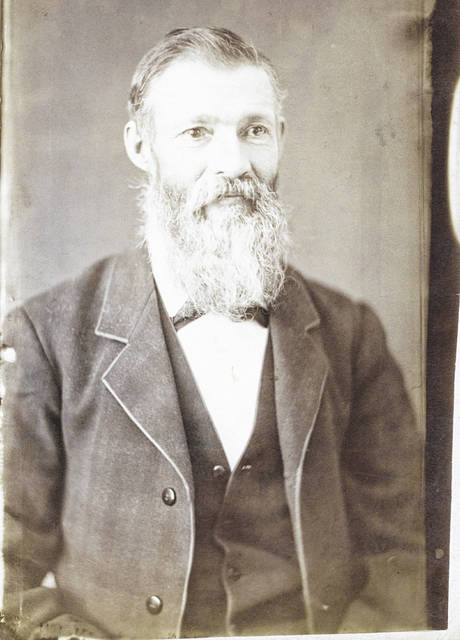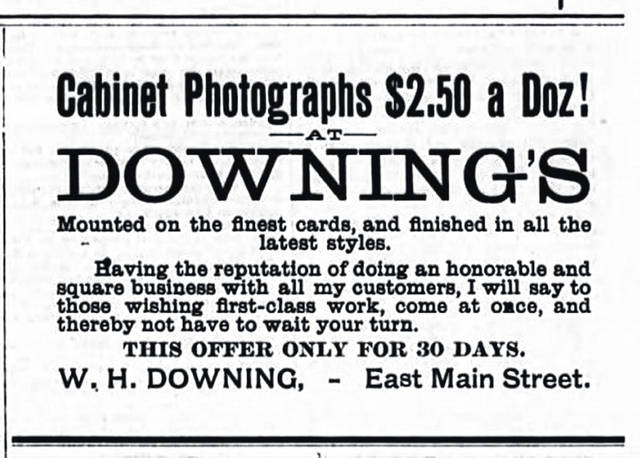

Editor’s note — The following is a story compiled by Christopher S. Duckworth, a longtime Ohio Historical Society employee with family ties to Hillsboro and Greenfield, about late Hillsboro photographer William Henry Downing.
William Henry Downing, a painter and photographer, was born in Mullion, Cornwall, England on Aug. 12, 1842. Before his first birthday his parents, Joseph and Christiana, sailed from Liverpool aboard the Columbus bound for New York City. On Jan. 9, 1843, the ship docked and the Downing family disembarked. They traveled first to Illinois and then to Ohio.
In the 1870 and 1880 census, William Henry Downing listed himself as a portrait painter, a profession that he apparently never abandoned. Although when and where he learned photography is unknown, he was an active and accomplished photographer by age 25. At that time, he was the partner of Edward B. Christmas in Mansfield. Their firm, Christmas and Downing, was in business from at least 1867 to 1868.
Downing moved to Hillsboro early in the 1870s, where he was practiced as both an accomplished portrait painter and a photographer. From 1872 to 1888, he was one of the town’s premier photographers who interests involved more than studio and darkroom.
Soon after arriving in Highland County, he met Mary Cecilia Grand Girard. She had been born in White Oak Township in 1841 to parents Emile and Georgiana. In August 1873, the couple married and three years later celebrated the birth of their son and only child, Grand Girard Downing.
Downing, by all appearances, was quite successful. He not only had his portrait clientele, but he also took photographs of local groups, stereoscopic views of notable Highland County sites, and other genres. In 1879, he purchased Newton Langley’s Photographic Gallery on East Main Street in Hillsboro. Formerly, the studio had been owned and operated by William Alexander Morrow (Times-Gazette, March 15, 2021). Downing was a skillful self-promoter whose name frequently appeared in the newspapers. In one notice, the newspaper remarked that “W. H. Downing, the East Main Street photographer, has certainly made a good offer to those desiring pictures. Six large cabinets for $1 was never offered here before.
He did not confine himself solely to taking individual and group portraits. Upon the assassination of President James A. Garfield in 1881, Downing offered memorial photographs that he had copied from photographs of the late president. Four years later, he hired Albert D. Frazee, an artist formerly from Cincinnati, and promised that “all lovers of the New York styles of position should give him an order.” In a competitive business, Downing was an innovative entrepreneur as well as an accomplished photographer.
Downing also was active in various public and civic affairs. Among other activities, he was chaplain of a fraternal lodge. Mary also was busy and frequently appeared in the society section of the newspaper. Hillsboro seemingly had become their established home. Then, in March 1888, they announced “House for Rent—Suitable for two families. Apply to W. H. Downing, at gallery.”
The Downing family was leaving Hillsboro, their home, and the ostensibly successful photography gallery. In September 1888, the News-Herald announced that “Mr. Wm. Downing has sold his photographic gallery to Mr. Chas. Fisher of Cincinnati.” A week later, the newspaper disclosed that Downing’s fellow Hillsboro photographer “Mr. J. Z. Foulk is thought by the Hillsboro Gazette to be going with Mr. Downing; at least Mr. Foulk has sold his artist’s outfit to Mr. Theodore George of Waverly.” What prompted the nearly simultaneous exodus of these two prominent photographs is unknown.
While John Zimmerman Foulk continued to pursue his career in photography and eventually landed a position at the prestigious Barker Art Gallery in Columbus, William and Mary Downing followed a much different path.
The couple moved from Hillsboro to Dayton, where by 1900 William had switched careers to become a carpenter. The couple next moved to Cincinnati where he continued in the carpentry trade. In February 1904, Mary died of “dropsy,” which today we know as edema, an abnormal accumulation of fluid in a body cavity or cellular tissues. Her funeral was held in Wilmington, in the home of a sister. Mary was buried in the nearby Sugar Grove Cemetery in the family plot with her father, mother, and other relatives.
William returned to Cincinnati, working as a carpenter before being ravaged by dementia. He died on April 1, 1924, and is buried alongside Mary.
Christopher S. Duckworth spent three decades at the Ohio Historical Society, where he was founding editor of Timeline magazine, followed by another 10 years at the Columbus Museum of Art. Today, he owns his own publishing company, Brevoort Press LLC.



